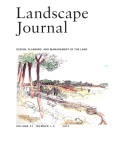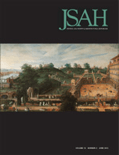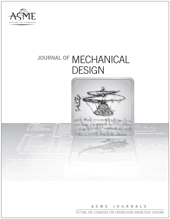
Journal of Interior Design
Scope & Guideline
Elevating Spaces, Inspiring Minds.
Introduction
Aims and Scopes
- Human-Centric Design:
Research emphasizing the role of human experiences and interactions within interior spaces, including user perceptions, behaviors, and psychological impacts. - Cultural and Historical Contexts:
Exploration of how cultural, historical, and social factors influence interior design practices and theories, including the study of specific movements and significant contributions by diverse groups. - Sustainability and Environmental Impact:
Investigations into sustainable design practices, environmental considerations, and the impact of interiors on health and wellbeing, particularly in light of contemporary challenges. - Technology in Design:
Integration of digital tools and technologies, such as virtual reality and augmented reality, into design processes and education, exploring their implications for practice and user experience. - Interdisciplinary Approaches:
Utilization of insights from various disciplines, including neuroscience, sociology, and anthropology, to inform and enhance interior design theory and practice.
Trending and Emerging
- Impact of COVID-19 on Design:
A significant focus on how the pandemic has reshaped interior environments, particularly regarding remote work, wellness, and the adaptation of spaces to meet new social and health standards. - Inclusivity and Diversity in Design:
Increased attention to issues of race, gender, and accessibility in design, emphasizing the importance of inclusive practices and the representation of diverse voices in the field. - Wellness and Well-Being:
A growing trend towards designing spaces that promote mental and physical health, reflecting a shift towards user-centric approaches that prioritize well-being in interior environments. - Technology-Enhanced Design Education:
Emerging themes around the use of technology in design education, including hybrid learning models and the incorporation of digital tools to enhance the learning experience. - Environmental Psychology:
Increasing interest in the psychological effects of interior spaces on individuals, focusing on how design can influence emotions, behaviors, and overall quality of life.
Declining or Waning
- Traditional Design Aesthetics:
There seems to be a waning interest in conventional design aesthetics that prioritize visual appeal over user experience, functionality, or cultural relevance. - Static Design Principles:
Research that adheres strictly to traditional design principles without considering dynamic and flexible approaches appears less frequently, indicating a shift towards more adaptable and context-sensitive methodologies. - Historical Preservation without Innovation:
While historical contexts remain important, there is a noted decrease in studies focused solely on preservation techniques without incorporating innovative design solutions or contemporary relevance. - Single-Disciplinary Studies:
There is a decline in publications that focus exclusively on interior design without interdisciplinary connections, as the field increasingly embraces collaborative approaches with other disciplines.
Similar Journals

DESIGN ISSUES
Challenging Perspectives in Design and ArtsDESIGN ISSUES, published by MIT PRESS, serves as a vital platform for scholarly discourse within the realms of design, arts, and humanities. With an ISSN of 0747-9360 and an E-ISSN of 1531-4790, this journal has established itself as a critical resource for researchers and practitioners alike, maintaining a significant presence in the academic community. As of 2023, it is ranked in the second quartile in Arts and Humanities (Miscellaneous) and the fourth quartile in Computer Graphics and Computer-Aided Design, showcasing its diverse scope and interdisciplinary approach. Spanning converged years from 2005 to 2024, DESIGN ISSUES fosters an exploration of contemporary design debates, theoretical advancements, and case studies, ensuring that it remains relevant and insightful amid the fast-evolving landscape of design practices. While not an open access journal, it is dedicated to enriching the academic and professional realms by engaging with pressing design issues, making it an essential read for anyone invested in the future of design.

Landscape Journal
Cultivating Research for a Greener FutureWelcome to the Landscape Journal, a prominent publication in the field of Nature and Landscape Conservation, proudly brought to you by University of Wisconsin Press. Since its inception, this journal has strived to underpin the critical interplay between environmental science and landscape architecture, providing a platform for innovative research and comprehensive insights. With an ISSN of 0277-2426 and an E-ISSN of 1553-2704, the Landscape Journal is indexed in leading academic databases and recognized with a 2023 Scopus Rank of #167, placing it in the 21st percentile among its peers. The journal operates from the heart of the United States, featuring converged years from 2009 to 2019 and again from 2021 to 2024, making it a reliable resource for ongoing dialogue in landscape studies. Although it currently does not offer open access, the Landscape Journal remains an essential resource for researchers, professionals, and students dedicated to understanding and enhancing our natural environments. As a Q3 category journal, it invites contributions that push the boundaries of landscape research while fostering environmental stewardship.

JOURNAL OF THE SOCIETY OF ARCHITECTURAL HISTORIANS
Bridging History and Modernity in Architectural StudiesJOURNAL OF THE SOCIETY OF ARCHITECTURAL HISTORIANS, published by the SOCIETY OF ARCHITECTURAL HISTORIANS, serves as a premier platform for the dissemination of scholarly research and critical discourse in the fields of architecture and architectural history. Established in 1970, this journal has undergone significant evolution, focusing on interdisciplinary studies that explore architectural heritage, theory, and practice. With a current impact factor that places it within the Q2 category in both History and Visual Arts and Performing Arts, as well as Q3 in Architecture, the journal maintains a robust reputation among academics and professionals alike. Although it operates under traditional access models, its essential role in fostering a deep understanding of architectural narratives and their socio-cultural contexts remains unparalleled. The journal also ranks favorably in Scopus, highlighting its importance in the arts and humanities, as well as engineering disciplines related to architecture. By bridging the gap between historical inquiry and contemporary architectural criticism, the JOURNAL OF THE SOCIETY OF ARCHITECTURAL HISTORIANS continues to be a vital resource for researchers, professionals, and students endeavoring to enrich their knowledge and contribute to this dynamic field.

JOURNAL OF MECHANICAL DESIGN
Elevating Standards in Mechanical Engineering Research.JOURNAL OF MECHANICAL DESIGN, published by the renowned American Society of Mechanical Engineers (ASME), is a leading peer-reviewed journal dedicated to the dissemination of cutting-edge research in the fields of mechanical engineering, computer graphics, and computer-aided design. With an impressive impact factor and categorized within the top Q1 quartile across multiple disciplines, it ranks among the most influential journals in engineering, aiming to foster innovation and collaboration among researchers and practitioners. The journal has maintained its stature since its inception in 1978, presenting articles that encompass a broad range of topics, including advanced design methodologies and novel applications of mechanical systems. The journal does not operate under an open-access model, ensuring that its content remains exclusive for its affiliated audience. As it plans to continue publishing until 2024, the JOURNAL OF MECHANICAL DESIGN stands as a crucial resource for professionals and academics seeking to enhance their knowledge and contribute to advancements in mechanical design.

International Journal of Information System Modeling and Design
Pioneering New Frontiers in Information Systems Theory and PracticeInternational Journal of Information System Modeling and Design, published by IGI Global, serves as a vital resource for researchers, professionals, and students in the rapidly evolving fields of Information Systems and Management of Technology and Innovation. With an ISSN of 1947-8186 and E-ISSN of 1947-8194, this journal has been a platform for disseminating cutting-edge research and innovative methodologies since its inception in 2010, with converged years extending through 2024. Although it currently holds a Q4 category ranking in both Information Systems and Management of Technology and Innovation, the journal is committed to enhancing its academic influence and aims to provide high-quality content that bridges theoretical frameworks and practical applications. Its Scopus rankings position it among relevant peers, making it an important conduit for advancing knowledge in technology management. Despite not being an open-access publication, the journal's content is backed by rigorous peer review, promising valuable insights for those engaged in the study and application of information systems.

METU Journal of the Faculty of Architecture
Elevating architecture research to new heights of excellence.METU Journal of the Faculty of Architecture is a reputable academic publication dedicated to advancing research and discourse in the field of architecture. Published by MIDDLE EAST TECHNICAL UNIVERSITY in Turkey, this journal serves as a vital platform for scholars and practitioners, addressing both theoretical and practical topics relevant to contemporary architectural studies. With an impact factor that positions it in the Q3 category for architecture as of 2023, and a Scopus rank of #133 out of 189 in Engineering Architecture, the METU Journal is an influential resource for innovative ideas and studies. Encompassing a wide range of scholarly articles, it fosters academic collaboration between researchers and professionals, making it essential reading for anyone passionate about the evolution of architecture. Though not open access, it provides crucial insights and rigorous research from 2008 up until 2024, contributing significantly to the global discourse on architectural practices and theories.

Design Journal
Elevating Design Knowledge for a Dynamic FutureDesign Journal, published by Routledge Journals, Taylor & Francis Ltd, serves as a pivotal platform for interdisciplinary research within the expansive fields of Arts and Humanities as well as Computer Graphics and Computer-Aided Design. With an ISSN of 1460-6925 and an E-ISSN of 1756-3062, this journal is dedicated to disseminating innovative ideas and methodologies that shape contemporary design practices. Ranked in the Q2 category in Arts and Humanities and Q3 in Computer Graphics per the 2023 category quartiles, it stands as a reference point for scholars and practitioners alike, fostering a vibrant community for sharing knowledge and fostering creativity. Researchers will find the journal's scope particularly valuable as it covers a diverse range of topics, providing insights critical for advancing knowledge and practice. With the journal continuing to evolve—converging research avenues from 2005 to 2024—it thrives as a beacon of scholarly excellence in the United Kingdom and beyond, appealing to professionals, researchers, and students eager to engage with cutting-edge design discourse.

Interiors-Design Architecture Culture
Unveiling the Artistry of Interior Design and ArchitectureInteriors - Design Architecture Culture is a prominent academic journal dedicated to exploring the multi-dimensional relationship between interiors, design, and architecture, while also emphasizing their cultural significance. Published by Routledge Journals, Taylor & Francis Ltd, this journal serves as an essential platform for innovative research in the fields of architecture, cultural studies, and visual arts. The journal, which has been disseminating vital findings since its inception in 2010, plays a crucial role in fostering interdisciplinary discourse, and it currently holds a Q4 rank in Architecture and Cultural Studies, alongside a Q3 rank in Visual Arts and Performing Arts. Though it operates under a traditional access model, the journal's rigorously peer-reviewed articles are vital for researchers, professionals, and students alike, contributing to an enriched understanding of how interior spaces shape, and are shaped by, cultural dynamics. With an ISSN of 2041-9112 and E-ISSN of 2041-9120, the journal continues to make significant contributions to the academic discourse surrounding the design and cultural narratives of interior spaces.

Design Science
Unleashing the Potential of Design Science.Design Science, published by Cambridge University Press, is a premier open access journal that has established itself as a leading platform for innovative research in the interdisciplinary field of design. Since its inception in 2015, the journal has focused on integrating design theories with practical applications across various sectors, including engineering, visual arts, and simulation modeling. With a remarkable impact factor and high rankings in multiple categories—Rank #11/667 in Visual Arts and Performing Arts and Rank #79/307 in General Engineering—Design Science commands a prominent position, being ranked in the top 98th, 76th, and 74th percentiles within its respective fields according to Scopus. The journal's dedication to open access ensures that cutting-edge research is accessible to a global audience, fostering collaboration and dialogue among researchers, professionals, and students alike. This journal not only aims to advance the understanding of design sciences but also serves as a vital resource for those seeking to explore the evolving dynamics of design practice in a rapidly changing technological landscape.

Anadolu Universitesi Sanat & Tasarim Dergisi-Anadolu University Journal of Art & Design
Fostering Interdisciplinary Dialogue in CreativityThe Anadolu Universitesi Sanat & Tasarim Dergisi (Anadolu University Journal of Art & Design) serves as a vital academic platform dedicated to the exploration and dissemination of innovative research in the fields of art and design. Published by ANADOLU UNIVERSITY, this journal aims to foster scholarly dialogue among artists, designers, and academics, encouraging interdisciplinary collaboration and the exchange of ideas. With an ISSN of 2146-9059, it provides a space for original articles, critical essays, and reviews that reflect the evolving nature of artistic and design practice. Although specific impact metrics are currently unavailable, the journal is committed to enhancing the visibility of art and design research within the academic community. By promoting open access to its content, the journal ensures that cutting-edge research is freely available, making it an essential resource for professionals, researchers, and students seeking to broaden their understanding of contemporary artistic trends and methodologies. Located in Eskisehir, Turkey, this journal not only contributes to the academic landscape but also enriches the cultural fabric of the region and beyond.